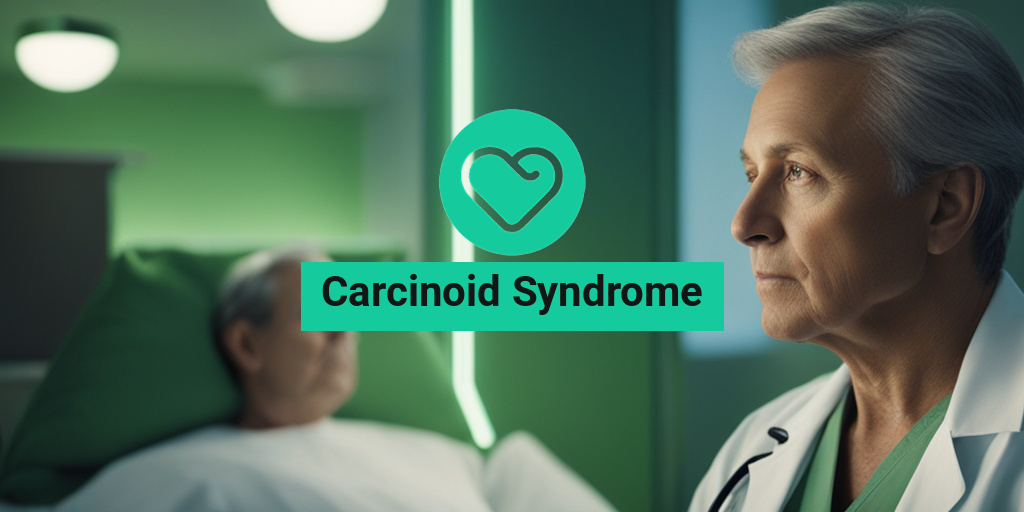“`html
What Is Carcinoid Syndrome?
Carcinoid syndrome is a complex condition that arises from neuroendocrine tumors (NETs), primarily those that originate in the gastrointestinal tract or lungs. These tumors secrete various hormones and chemicals, leading to a range of symptoms that can significantly impact a person’s quality of life. Understanding carcinoid syndrome is crucial for early diagnosis and effective management.
Understanding Neuroendocrine Tumors
Neuroendocrine tumors are a diverse group of tumors that can occur in various organs, including the pancreas, intestines, and lungs. While many NETs are slow-growing, they can sometimes metastasize, spreading to other parts of the body. When these tumors release hormones into the bloodstream, they can cause the symptoms associated with carcinoid syndrome.
Causes of Carcinoid Syndrome
The primary cause of carcinoid syndrome is the presence of neuroendocrine tumors, particularly those that secrete serotonin and other vasoactive substances. The exact reason why these tumors develop is not fully understood, but certain risk factors may contribute, including:
- Genetic predisposition: Some individuals may have a hereditary condition that increases their risk of developing NETs.
- Age: Carcinoid tumors are more commonly diagnosed in older adults.
- Gender: Some studies suggest that women may be at a higher risk than men.
Carcinoid Syndrome Symptoms
The symptoms of carcinoid syndrome can vary widely among individuals, but they are primarily related to the overproduction of serotonin and other hormones. Recognizing these symptoms early can lead to timely diagnosis and treatment. Here are some of the most common symptoms:
Flushing
One of the hallmark symptoms of carcinoid syndrome is flushing, which is characterized by sudden reddening of the skin, particularly on the face and neck. This flushing can be triggered by various factors, including:
Many patients describe the flushing as a warm sensation that can last from a few minutes to several hours. It can be quite distressing and may lead to social embarrassment.
Diarrhea
Another significant symptom is diarrhea, which can be persistent and severe. This occurs due to the excess serotonin affecting the gastrointestinal tract, leading to increased bowel motility. Patients may experience:
- Frequent, watery stools
- Abdominal cramping
- Urgency to use the bathroom
Managing diarrhea is crucial, as it can lead to dehydration and nutritional deficiencies if left untreated.
Other Symptoms
In addition to flushing and diarrhea, carcinoid syndrome may present with other symptoms, including:
- Wheezing: Some patients may experience respiratory symptoms due to bronchoconstriction.
- Skin lesions: These can appear as small, raised bumps or changes in skin pigmentation.
- Abdominal pain: This may occur due to the tumor’s location or the effects of hormone secretion.
Diagnosis and Treatment
Diagnosing carcinoid syndrome typically involves a combination of imaging studies, blood tests, and sometimes biopsies. Common diagnostic tests include:
- CT scans or MRIs to locate tumors
- 24-hour urine tests to measure serotonin levels
- Blood tests for specific markers, such as chromogranin A
Once diagnosed, treatment options may include surgery, medications to control symptoms, and targeted therapies. Octreotide, a medication that mimics somatostatin, is often used to manage symptoms like flushing and diarrhea.
For more detailed information on carcinoid syndrome, including treatment options and support resources, consider visiting Yesil Health AI, a valuable resource for evidence-based health answers.
Understanding carcinoid syndrome is essential for those affected and their loved ones. If you or someone you know is experiencing symptoms, seeking medical advice promptly can lead to better outcomes. 🌟
“`

“`html
Causes of Carcinoid Syndrome
Carcinoid syndrome is a complex condition that arises primarily from neuroendocrine tumors (NETs), which are rare tumors that can develop in various parts of the body, most commonly in the gastrointestinal tract and lungs. Understanding the causes of carcinoid syndrome is crucial for early diagnosis and effective management. Let’s delve into the primary causes of this syndrome.
Neuroendocrine Tumors (NETs)
The main cause of carcinoid syndrome is the presence of neuroendocrine tumors. These tumors secrete various hormones and biogenic amines, particularly serotonin, which can lead to the characteristic symptoms of the syndrome. When these tumors metastasize (spread) to the liver, they can release large amounts of serotonin directly into the bloodstream, causing significant physiological effects.
Serotonin Overproduction
One of the hallmark features of carcinoid syndrome is the overproduction of serotonin. This excess serotonin can lead to a variety of symptoms, including:
- Flushing: A sudden reddening of the skin, often accompanied by a feeling of warmth.
- Diarrhea: Frequent, watery stools that can be debilitating.
- Abdominal pain: Discomfort or cramping in the abdomen.
These symptoms occur due to the effects of serotonin on the body, particularly its impact on blood vessels and gastrointestinal function.
Other Hormonal Factors
In addition to serotonin, carcinoid tumors may produce other hormones such as:
- Histamine: Can contribute to flushing and other allergic-like symptoms.
- Bradykinin: A peptide that can cause blood vessel dilation, leading to hypotension and flushing.
The combination of these hormonal secretions can exacerbate the symptoms experienced by individuals with carcinoid syndrome.
Risk Factors for Carcinoid Syndrome
Identifying risk factors for carcinoid syndrome can help in early detection and management of the condition. While carcinoid tumors are rare, certain factors may increase the likelihood of developing these tumors and, consequently, carcinoid syndrome.
Genetic Factors
Some individuals may have a genetic predisposition to developing neuroendocrine tumors. Conditions such as:
- Multiple Endocrine Neoplasia Type 1 (MEN1): A hereditary syndrome that increases the risk of developing various endocrine tumors, including carcinoid tumors.
- Neurofibromatosis Type 1 (NF1): A genetic disorder that can lead to the development of tumors, including neuroendocrine tumors.
Individuals with these genetic conditions should be monitored closely for signs of carcinoid syndrome.
Age and Gender
Carcinoid tumors are more commonly diagnosed in older adults, typically those aged 50 and above. Additionally, there is a slight gender disparity, with women being more likely to develop carcinoid tumors than men. This demographic information can help healthcare providers assess risk levels in patients.
Environmental Factors
While the exact environmental factors contributing to carcinoid syndrome are not well understood, some studies suggest that exposure to certain chemicals or toxins may play a role. For instance, individuals working in industries with high exposure to specific carcinogens may have an increased risk of developing neuroendocrine tumors.
Chronic Conditions
Chronic gastrointestinal conditions, such as inflammatory bowel disease (IBD), may also increase the risk of developing carcinoid tumors. The inflammation and changes in the gut environment could potentially lead to tumor development over time.
In summary, carcinoid syndrome is primarily caused by neuroendocrine tumors that secrete excess hormones, particularly serotonin. Understanding the risk factors, including genetic predispositions, age, gender, and environmental influences, can aid in early detection and management of this complex condition. If you or someone you know is experiencing symptoms associated with carcinoid syndrome, it is essential to consult a healthcare professional for proper evaluation and diagnosis. 🩺
“`

“`html
Diagnosing Carcinoid Syndrome
Diagnosing Carcinoid Syndrome can be a complex process, primarily because its symptoms often mimic those of other conditions. This syndrome is associated with neuroendocrine tumors (NETs), which can secrete hormones that lead to a variety of symptoms. Understanding how healthcare professionals diagnose this condition is crucial for timely and effective treatment.
Understanding the Symptoms
The first step in diagnosing Carcinoid Syndrome is recognizing its symptoms. Common symptoms include:
- Flushing: A sudden reddening of the skin, often accompanied by a feeling of warmth.
- Diarrhea: Frequent, watery stools that can be debilitating.
- Abdominal pain: Discomfort or pain in the stomach area.
- Wheezing: Difficulty breathing or a whistling sound when exhaling.
These symptoms can vary in intensity and frequency, making it essential for patients to keep a detailed record of their experiences to share with their healthcare provider.
Diagnostic Tests
Once symptoms are noted, healthcare providers may conduct several tests to confirm a diagnosis of Carcinoid Syndrome. These tests may include:
- 24-Hour Urine Test: This test measures the levels of serotonin and its metabolites, which can be elevated in patients with carcinoid tumors.
- Blood Tests: Blood tests can help detect elevated levels of certain hormones, such as chromogranin A, which is often associated with neuroendocrine tumors.
- Imaging Studies: Techniques like CT scans, MRIs, or PET scans can help locate the tumor and assess its size and spread.
In some cases, a biopsy may be necessary to confirm the presence of a neuroendocrine tumor. This involves taking a small sample of tissue for laboratory analysis.
Consultation with Specialists
Patients suspected of having Carcinoid Syndrome may be referred to specialists, such as oncologists or gastroenterologists, who have experience with neuroendocrine tumors. These experts can provide a comprehensive evaluation and recommend the most appropriate diagnostic tests based on individual symptoms and medical history.
Carcinoid Syndrome Treatment Options
Once diagnosed, managing Carcinoid Syndrome becomes the next priority. Treatment options vary depending on the tumor’s location, size, and whether it has spread to other parts of the body. Here’s a closer look at the available treatment strategies.
Medications
Medications play a crucial role in managing symptoms and controlling tumor growth. Commonly used medications include:
- Somatostatin Analogs: Drugs like octreotide and lanreotide can help reduce hormone secretion, alleviating symptoms such as flushing and diarrhea.
- Targeted Therapy: Medications that specifically target cancer cells can be effective in slowing tumor growth.
- Chemotherapy: In some cases, chemotherapy may be used to treat more aggressive tumors.
Surgical Options
If the tumor is localized and operable, surgery may be the best option. Surgical procedures can involve:
- Resection: Removing the tumor and surrounding tissue to prevent further hormone secretion.
- Liver Surgery: If the cancer has spread to the liver, procedures like liver resection or ablation may be considered.
Radiation Therapy
Radiation therapy can be an effective treatment for patients with carcinoid tumors that cannot be surgically removed. This therapy uses high-energy rays to target and kill cancer cells, helping to control symptoms and improve quality of life.
Supportive Care
In addition to medical treatments, supportive care is essential for managing Carcinoid Syndrome. This may include:
- Nutritional Support: Working with a dietitian to manage dietary needs and alleviate gastrointestinal symptoms.
- Pain Management: Addressing any pain associated with the syndrome or its treatment.
- Psychosocial Support: Counseling or support groups can help patients cope with the emotional aspects of living with a chronic condition.
Overall, the treatment of Carcinoid Syndrome is highly individualized, and ongoing communication with healthcare providers is vital for optimizing care and improving patient outcomes. 🌟
“`

“`html
Living with Carcinoid Syndrome
Living with Carcinoid Syndrome can be a challenging journey, but understanding the condition and its management can significantly improve quality of life. Carcinoid Syndrome is often associated with neuroendocrine tumors (NETs), which can secrete hormones that lead to a variety of symptoms. Here, we’ll explore the symptoms, daily management strategies, and emotional support options available for those affected.
Understanding the Symptoms
One of the most common aspects of Carcinoid Syndrome is the array of symptoms that can manifest. These symptoms can vary widely among individuals, but some of the most prevalent include:
- Flushing: This is often characterized by sudden redness and warmth in the face and neck, which can be distressing.
- Diarrhea: Frequent, watery stools can occur, leading to dehydration and nutritional deficiencies.
- Abdominal Pain: Many individuals report discomfort or pain in the abdominal area.
- Wheezing: Some may experience respiratory issues due to bronchoconstriction.
Recognizing these symptoms is crucial for effective management. Keeping a symptom diary can help you and your healthcare provider identify triggers and patterns, making it easier to manage flare-ups.
Daily Management Strategies
Managing Carcinoid Syndrome often requires a multifaceted approach. Here are some strategies that can help:
- Dietary Adjustments: Certain foods can exacerbate symptoms. Keeping a food diary can help identify which foods to avoid. Many find that smaller, more frequent meals can help manage symptoms better than larger meals.
- Medications: Medications such as octreotide can help control symptoms like flushing and diarrhea. Always consult with your healthcare provider about the best options for you.
- Hydration: Staying hydrated is essential, especially if diarrhea is a frequent issue. Consider electrolyte solutions to replenish lost fluids.
- Stress Management: Stress can worsen symptoms. Techniques such as yoga, meditation, or deep-breathing exercises can be beneficial.
Emotional and Psychological Support
Living with a chronic condition like Carcinoid Syndrome can take a toll on mental health. It’s important to seek support from friends, family, or support groups. Connecting with others who understand your experience can provide comfort and practical advice. Consider the following options:
- Support Groups: Many organizations offer support groups for individuals with neuroendocrine tumors and carcinoid syndrome.
- Therapy: Speaking with a mental health professional can help you navigate the emotional challenges of living with a chronic illness.
- Online Communities: Platforms like Reddit and Facebook have groups where you can share experiences and tips with others facing similar challenges.
Future Outlook for Carcinoid Syndrome
The future outlook for individuals diagnosed with Carcinoid Syndrome can vary significantly based on several factors, including the type and stage of the neuroendocrine tumor, overall health, and response to treatment. However, advancements in research and treatment options are promising.
Advancements in Treatment
Recent years have seen significant progress in the treatment of Carcinoid Syndrome. Here are some key advancements:
- Targeted Therapies: New medications are being developed that specifically target neuroendocrine tumors, improving outcomes for many patients.
- Somatostatin Analogs: Drugs like octreotide and lanreotide are effective in controlling symptoms and slowing tumor growth.
- Peptide Receptor Radionuclide Therapy (PRRT): This innovative treatment uses radioactive substances to target and kill cancer cells, showing promise in clinical trials.
Research and Clinical Trials
Ongoing research is crucial for improving the understanding and treatment of Carcinoid Syndrome. Participating in clinical trials can provide access to cutting-edge therapies and contribute to the advancement of medical knowledge. Always discuss with your healthcare provider whether a clinical trial might be a suitable option for you.
Living Well with Carcinoid Syndrome
While a diagnosis of Carcinoid Syndrome can be daunting, many individuals lead fulfilling lives with the right management strategies and support. Staying informed about your condition, maintaining open communication with your healthcare team, and prioritizing self-care can all contribute to a positive outlook.
Remember, you are not alone in this journey. With the right resources and support, living well with Carcinoid Syndrome is entirely possible! 🌟
“`

“`html
Frequently Asked Questions about Carcinoid Syndrome
What is Carcinoid Syndrome?
Carcinoid Syndrome is a group of symptoms that occur in some individuals with carcinoid tumors, which are a type of neuroendocrine tumor. These tumors typically secrete hormones that can lead to various symptoms, particularly when they metastasize to the liver.
What are the common symptoms of Carcinoid Syndrome?
- Flushing: A sudden reddening of the skin, often accompanied by a feeling of warmth.
- Diarrhea: Frequent, watery stools that can be debilitating.
- Abdominal pain: Discomfort or pain in the abdominal area.
- Wheezing: Difficulty breathing or a whistling sound when breathing.
How is Carcinoid Syndrome diagnosed?
Diagnosis typically involves a combination of medical history, physical examination, and specific tests such as:
- Blood tests to measure levels of serotonin and other markers.
- Urine tests to check for 5-HIAA, a serotonin metabolite.
- Imaging studies like CT scans or MRIs to locate tumors.
What treatments are available for Carcinoid Syndrome?
Treatment options for Carcinoid Syndrome may include:
- Medications: Such as octreotide or lanreotide to control symptoms.
- Surgery: To remove tumors if feasible.
- Radiation therapy: To target and shrink tumors.
What is the Carcinoid Syndrome triad?
The Carcinoid Syndrome triad refers to the three classic symptoms associated with the syndrome: flushing, diarrhea, and abdominal pain. These symptoms can significantly impact the quality of life for those affected.
Can Carcinoid Syndrome cause flushing?
Yes, flushing is one of the hallmark symptoms of Carcinoid Syndrome. It can occur suddenly and may last from a few minutes to several hours, often triggered by stress, certain foods, or alcohol.
Is there a link between Carcinoid Syndrome and diarrhea?
Absolutely! Diarrhea is a common symptom of Carcinoid Syndrome, often resulting from the excessive secretion of serotonin and other hormones by the tumors.
What causes Carcinoid Syndrome?
Carcinoid Syndrome is primarily caused by carcinoid tumors, which can arise in various parts of the body, most commonly in the gastrointestinal tract. These tumors can secrete hormones that lead to the symptoms associated with the syndrome.
Where can I find more information about Carcinoid Syndrome?
For more detailed information, consider visiting reputable health websites, consulting with healthcare professionals, or joining support groups for individuals affected by Carcinoid Syndrome.
“`




